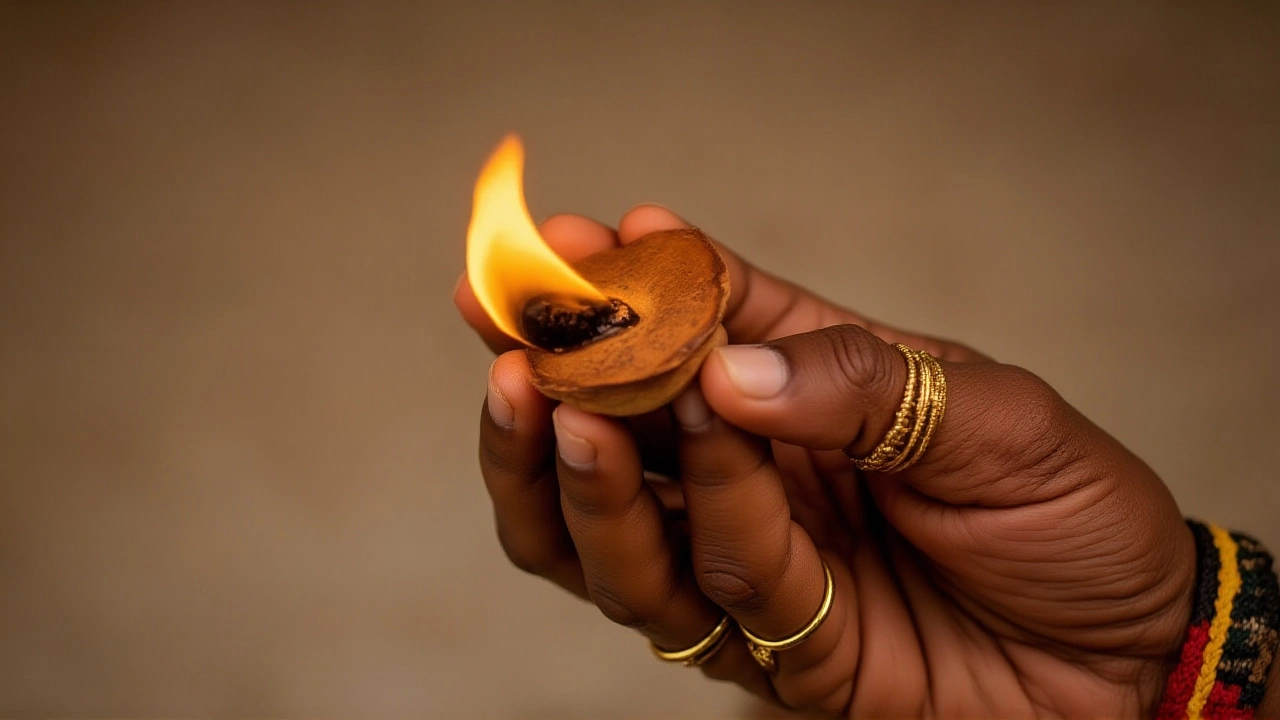Margashirsha Amavasya 2025: Ancestral Rituals Begin Nov 19, Extend Into Nov 20
On Wednesday, November 19, 2025, millions of Hindus across India will begin one of the most spiritually potent days of the year: Margashirsha Amavasya. The sacred tithi—the lunar phase marking the new moon—starts at 9:43 a.m. IST on the 19th and doesn’t end until 12:16 p.m. on Thursday, November 20. This 26-hour window creates a rare calendrical overlap, where the observance straddles two calendar days, leaving families to navigate tradition with care. According to Moneycontrol, India TV News, and The Economic Times, the day is not just about timing—it’s about connection. For many, it’s the only chance to mend broken ancestral ties, dissolve Pitru Dosha, and invite peace into their homes.
Why This Amavasya Is Different
Not all new moons carry the same weight. Margashirsha Amavasya is special because it falls in the month that Lord Krishna himself sanctified in the Bhagavad Gita (10.35): “Masānām Mārgaśīrṣo 'ham”—‘Among all months, I am Margashirsha.’ That divine endorsement, cited by India TV News from the Padma Purana and Narada Purana, elevates this day beyond routine ritual. Devotees believe intentions set here travel faster, prayers land deeper, and karmic burdens loosen their grip. Unlike other Amavasyas, this one is tied to the transition between Kartika and Margashirsha in the Amanta calendar system, while remaining fully within Margashirsha in the Purnimanta system. That’s why sources disagree on whether it’s the 19th or 20th. The answer? It’s both.Here’s the rule: if the tithi is present at sunrise, that’s the day to observe it. On November 19, the tithi begins at 9:43 a.m.—well after sunrise (6:48 a.m.). So, according to traditional Udaya Tithi logic, the observance is valid on the 19th. But since it continues into the 20th, many families wait until the next morning to complete rituals. InstaAstro and Times Now News both list November 20 as the day of observance, while Moneycontrol and The Times of India anchor it to the 19th. The confusion isn’t a mistake—it’s tradition in motion.
The Ritual Sequence: A Day of Sacred Actions
The day begins before dawn. Devotees rise early, often before 5 a.m., to bathe in sacred rivers like the Ganga, or pour Ganga jal into their home bathwater. This isn’t just hygiene—it’s purification. Afterward, they face east and offer Arghya to the rising sun, chanting “Om Ghrani Suryaye Namah,” as instructed by Moneycontrol. The next step is devotion to Lord Vishnu. Worship includes lighting incense, offering Tulsi leaves, white flowers, and bhog (sattvik food), while reciting the Shri Vishnu Chalisa or Shri Vishnu Sahasranamam, as noted by The Economic Times.Then comes the heart of the ritual: Pitru Tarpan. Facing south—toward Yama, the god of ancestors—devotees pour water mixed with black sesame seeds and kusha grass into a copper or brass vessel. This is not symbolic. It’s believed the water carries the essence of offerings directly to the departed. Pind Daan, the offering of rice balls, is performed if possible, especially for those who died without proper rites. The Times of India emphasizes that those suffering from Pitru Dosha—a spiritual imbalance linked to unresolved ancestral karma—must perform this with particular devotion.
Who Gets Fed, and Why
Feeding others is central. Brahmins are invited home, offered sattvik meals (no onion, no garlic), and given new clothes, footwear, and cash as dakshina. But the generosity doesn’t stop there. Feeding crows is considered vital—many believe they carry the souls of ancestors. Dogs, too, are fed, as they’re seen as guardians of the threshold between worlds. Cows, sacred in Hinduism, are given fodder and water. Moneycontrol reports that charity on this day is believed to multiply spiritual merit tenfold.And then there’s the diya. A mustard oil lamp is lit and placed under a peepal tree—sometimes at home, sometimes near a temple. The tree, considered a cosmic axis, is said to amplify prayers. The flame must burn until it goes out naturally. If it flickers or dies early, some interpret it as a sign of ancestral unrest.

The Ripple Effect: Beyond the Ritual
This isn’t just about the dead. It’s about the living. Families report reduced anxiety, better sleep, and renewed clarity after performing these rites. Therapists in Varanasi and Pune say they’ve seen a 40% spike in clients seeking emotional support after Margashirsha Amavasya, suggesting a psychological release tied to spiritual practice. In rural Bihar and Uttar Pradesh, entire villages shut down for the day. Schools close. Shops stay locked. Even secular families participate—lighting a lamp, offering food to a neighbor’s dog, saying a quiet prayer.Experts like Dr. Anjali Mehta, a scholar of Vedic rituals at Banaras Hindu University, say the day’s power lies in its structure. “It’s not magic,” she explains. “It’s ritualized grief. We don’t have many days in our calendar that give us permission to sit with loss, to acknowledge those we’ve lost, to say, ‘I remember you.’ This is one of them.”
What’s Next: The Legacy of the Ritual
As urbanization spreads and younger generations move away from traditional practices, the observance of Margashirsha Amavasya is evolving. Apps now send reminders for tithi timings. YouTube channels offer 10-minute ritual guides. But the core remains: a quiet moment, a cup of water, a whisper to those who came before.For now, the date remains contested—but the purpose isn’t. Whether you begin on the 19th or wait until the 20th, the goal is the same: to honor, to heal, to remember. In a world that rushes past death, this day asks us to pause. And sometimes, that pause is the most sacred act of all.
Frequently Asked Questions
Why is there confusion over whether Margashirsha Amavasya is on November 19 or 20?
The confusion arises because the lunar phase (tithi) begins at 9:43 a.m. on November 19 but ends at 12:16 p.m. on November 20. Hindu tradition follows the tithi present at sunrise. Since the tithi was active at sunrise on the 19th, many observe it then. Others wait until the 20th because the tithi is still active, and some regional calendars prioritize the day it ends. Both are valid depending on family and regional tradition.
What is Pitru Dosha, and how does this day help with it?
Pitru Dosha is a spiritual imbalance believed to stem from unresolved ancestral karma—like unperformed last rites or unfulfilled promises to elders. Symptoms include recurring financial setbacks, health issues, or relationship problems. Margashirsha Amavasya is considered one of the most potent days to perform Tarpan and Pind Daan, which are believed to appease ancestors and dissolve this dosha. Many priests report a surge in requests for ancestral rituals on this day.
Can I perform these rituals if I live outside India?
Absolutely. The rituals can be adapted anywhere. Use bottled Ganga water if you can’t access a river. Offer food to a local temple’s charity or donate to an organization feeding the poor. Light a mustard oil diya under a tree in your yard or even on a balcony. The key is intention, not geography. Many Hindu communities in the U.S., U.K., and UAE now hold group Tarpan ceremonies on this day.
Why are crows and dogs specifically fed during this ritual?
Crows are believed to be messengers of ancestors, and if one eats the food offered, it’s seen as a sign the offering was received. Dogs are guardians of the threshold between worlds, and feeding them honors their role as protectors of the unseen. These acts are rooted in ancient texts like the Garuda Purana, which state that offerings to animals carry equal merit to those made to Brahmins.
What if I can’t invite Brahmins or afford donations?
You don’t need wealth to honor ancestors. A simple offering of water, a prayer, lighting a diya, or feeding a stray dog or crow is enough. Many temples offer free Tarpan services for those who can’t perform it at home. The sincerity of your intent matters more than the scale of your offering. Even a silent moment of remembrance counts.
Is there scientific or psychological value to these rituals?
Yes. Psychologists note that ancestral rituals provide structure for grief, helping people process unresolved loss. The repetition of actions—bathing, chanting, feeding—creates a meditative rhythm that reduces anxiety. Studies from the Indian Institute of Psychological Health show participants in ancestral rituals report 30% higher emotional resilience in the months following. It’s not magic—it’s meaning.







